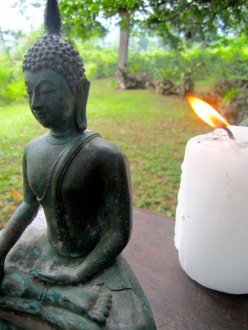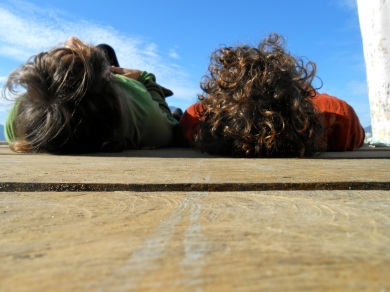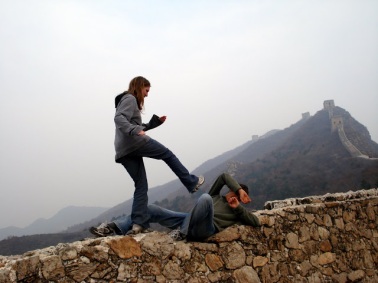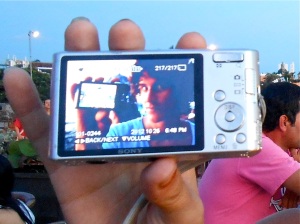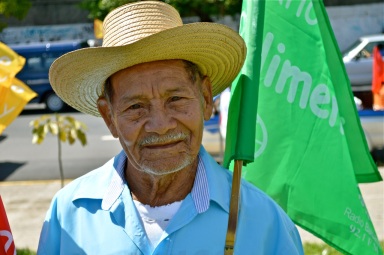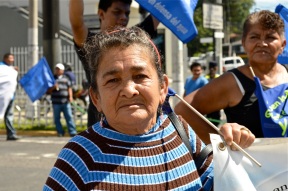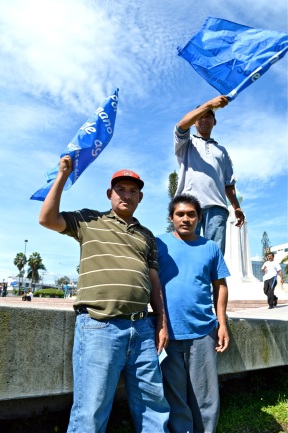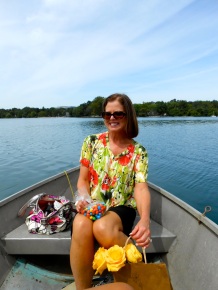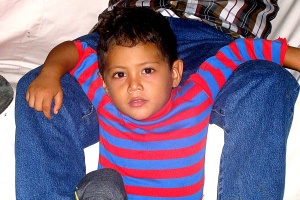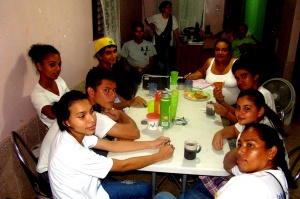Get Your Hand off My Heart Chakra: On Pranic Healing
November 26, 2013 § 2 Comments
When my career in international development brought me to Nicaragua a year ago, I decided to read up on Nicaragua’s tumultuous history with Steven Kinzer’s Blood of Brothers. While the book did a masterful job of capturing the realities of Somoza dictatorship, the Sandinista revolution, and the disastrous policies of the Regan administration, I found myself drawn to one element Kinzer was unable to explain about Nicaragua – magic.
During a visit to the Miskito Indian village of Saupuka, Kinzer observed a woman running from the jungle, shrieking with a limp baby in her arms. Kinzer was sure the baby, who had fallen into the sacred Coco River, was dead. That was until a woman stepped forward from the shadows of the jungle and began chanting before the baby in a strange language.
“Everyone fell silent and watched, some clasping their hands to their faces in expressions of awe,” Kinzer wrote. “After a few minutes, the woman produced some flower petals and scattered them over the infant’s tiny body, chanting all the while.”
With a gentle slap to the baby’s chest, the baby stirred, opened its eyes, and began crying. Kinzer was convinced he had witnessed a resurrection. When he asked the woman what she had done to bring the child back to life, she said she wasn’t sure and walked away.
The story was enough to inspire me to learn more about the art of healing in Nicaragua in any of its non-Western forms. Unable to take vacation days just yet, I had to seek out that magic a little closer to home than Saupuka. That brought me to the Pranic Healing Association of Nicaragua in Managua.
My interest in pranic healing dates back to the yoga teacher training course I took at Yoga Vidya Gurukul in India. I was intrigued by the people who held their hands above their dishes of ashram food, closing their eyes and fixating on the energy they were about to consume. One of those students, Shaman M, was a practitioner of Reike. Whenever any of the other students suffered an injury, Shaman M would treat them with her pranic energy. After a single session with Shaman M, the students would return to asana class elated and as good as new.
The art of pranic healing is based on the utilization of prana, or the body’s vital energy (known as chi in Chinese, ki in Japanese, pneuma in Greek, and ruha in Hebrew). It is said that when this invisible energy is imbalanced, it can manifest as pain or illness.
On my first day of pranic healing class, I noticed right away that I was the youngest person in the room. The five other students, all from Nicaragua, included two middle-aged women, two elderly ladies, and an older man. We reviewed the concept of prana and watched as our instructor measured out the aura of our classmate, Nivia.
“Here’s where Nivia’s aura ends,” the instructor, Priscila, told us. Priscila was a frail lady with bony fingers, curly black hair, and wiry glasses. “I can feel it all the way out here.”
Meanwhile, Nivia was making orgasm face, her eyes closed and her mouth slightly open.
It wasn’t hard for anyone to notice that Nivia had come to class with her hand wrapped in a white bandage. Priscila failed to mention anything about the bandage, but she was quick to tell us that she sensed a large protrusion coming from the aura in the direction of Nivia’s wounded hand.
“Something is definitely wrong with that hand,” Priscila said. “You can feel it in her energy. Can’t you feel it?”
The older pranic healing students smiled and nodded. I, however, was baffled.
Of course there is something wrong with her hand, I wanted to say. It’s wrapped in a bandage!
The doubt must have shown itself on my face, since Priscila wasted no time in singling me out.
“Michael, come here and feel this energy.”
I gulped as I stood up from my seat. I neared the spot where Priscila’s hands were and lifted mine.
“Don’t you feel it?” Priscila asked. “Right here?”
“I don’t know,” I said, shifting my hands through the air. “Maybe?”
I suddenly felt like I was back in kindergarten – the days when my friends and I would blast invisible bolts of lightning from our fists to destroy legions of mentally conjured zombie foes. I had enjoyed using my imagination and playing those games, back in the day. I found it odd, almost frightening, that two decades could erase that curiosity, replacing my childhood wonder with adult cynicism.
“Now I can feel it,” I told Priscila, saying what was necessary to escape the horribly awkward situation. “It’s kind of warm.”
Priscila nodded and allowed me to take my seat.
We proceeded to break up into pairs and cleanse each other’s auras. My partner, a senior citizen named Celia, complained of knee issues. That meant I had to scoop away invisible clumps of energy from the bottom of her aura. Priscila taught us how to move our hands – not too fast and not too slow – and then to toss the excess prana into a bucket of water. The bases of the buckets were speckled with dirt that someone (I assumed Priscila) had placed inside to give the impression that we were doing some heavy duty cleaning. After cleansing the affected areas, we had to charge them with light that we’d draw from the sky and zap from our hands.
The founder of the pranic healing school, Master Choa Kok Sui, was a Chinese-Filipino man whose enlarged photos were scattered throughout the center. He was a plump guy with pinchable cheeks who dressed himself in business suits and colorful scarves. He had recorded several different kinds of meditations where he’d say things in a thick accent like, “Can you feel the divine love and the divine sweetness gathering at your crown center?”
I asked Priscila if Master Choa Kok Sui, who was only talked about in the present tense, had ever visited the center.
“No,” Priscila said. Her face went pale, as though I had just revealed some dark secret of hers in public.
“Why not?”
“He’s…transitioned.”
“Wait — he’s dead?” I asked, my voice cracking with surprise. “How old was he when he died?”
“About fifty-eight.”
“Fifty-what? But…how?”
“Cancer,” she said, her answer a whisper.
Cancer? Did the man who designed the pranic healing methodology that was meant to heal the body and protect it from all kinds of diseases really die from cancer at the age of fifty-eight?
I couldn’t believe it. Even my grandmother, an overweight woman with diabetes who lived on KFC and rode around on a motor scooter, not because she needed to but because she was too lazy to walk, outlived Master Choa Kuk Sui. What was I doing sitting in a room, learning about the art of healing at the institute of a man who wasn’t even able to practice what he preached?
After two full days of feeling out auras, removing invisible clumps of energy, throwing said energy into buckets of dirty water, and attempting to heal people in faraway places, I was still struggling with the foundations of the practice. In one of our final exercises, three students sat directly across from the other three. The two students on my side and I closed our eyes while the other three cleansed one of our chakras. Priscila whispered the chakra that they needed to clean, and afterwards we were supposed to guess where it was we felt the energy.
“My forehead?” I asked after my cleansing.
“Wow, he felt it all the way up in his forehead,” Priscila said.
“So it wasn’t my forehead?” I asked.
My partner, Celia, shook her head.
“It was your sex chakra,” she told me.
For the past five minutes, Celia had been focusing on my sex chakra with all of her old lady might, cleansing my groin of its invisible energy and charging it back up with hers.
“Celia’s energy must be very powerful if it went all the way up to your forehead,” Priscila told me. “Or maybe it’s Celia’s energy that caused it, since your auras are interfering with each other.”
“Should we be sitting farther apart?” I asked.
Priscila shook her head. “No. Celia, how long have you been a widow for?”
“Oh! Too long!” Celia said with a cackle.
Priscila nodded. “I’m sensing a great disturbance in your sex chakra. Widows often have a lot of pent up energy.”
“How am I supposed to fix that if I don’t have anyone to use it on?” Celia asked.
The whole class of Nicaraguans burst out laughing, Celia included.
“Did you sense any tension in Michael’s chakra?” Priscila asked.
Celia and I made eye contact. She smiled at me and shook her head.
“I don’t think he has that problem.”
Again, the class burst out into laughter.
“But what I sense in Michael every time I feel his aura is something in his heart chakra,” Celia added. “There’s a lot of buildup around his heart. It’s really strong.”
I winced at the thought of my heart chakra. Ever since I was little, I never liked thinking about hearts, nor did I ever like having that part of my body touched. The disturbing sensation it produced was enough to make me collapse to the floor and curl up on myself. The phenomenon had always been a source of entertainment for friends and lovers, many of whom had taken to jabbing at my heart when I wasn’t paying attention.
“Who knows?” Priscila asked. “Maybe Michael has left a special girl behind somewhere on one of his travels.”
Oh, Priscila, I thought with a sigh. If she was incapable of realizing that my sex chakra had a preference for men, how could she possibly possess the capacity to feel out my aura? As far as I was concerned, she was a fraud who had somehow found peace in the dance-like art of scooping air.
Though I didn’t believe that Priscila was a true healer, that didn’t discount the idea that true healers could exist. Just like the Miskito woman in the jungle and Shaman M, I still thought those types of healers could be found in different parts of the world. But their gifts were unique and couldn’t be accessed by all people, let alone after a two-day workshop.
But maybe there’s some potential in Celia, I wondered. Without me ever having said anything, she was able to sense the buildup, the discomfort, and the tension. Shaman M once told me that I couldn’t touch my heart because my heart chakra was closed. She didn’t explain any further. She just allowed me to ponder the concept. The possibility. The broken heart.
If pranic healing were a crapshoot, perhaps it was an easy enough gamble to assume that most people, at some point or another, have suffered the effects of a wounded heart. Mine has definitely been broken, and sometimes I still wonder if it has ever fully healed. Emotional, not just physical, pain can supposedly manifest into the energy that forms our auras.
“How long does it take to go away?” I asked Celia at the end of class.
By it, I didn’t have to explain much else. Celia already knew.
“Look, Michael,” she said. “I’ve been a widow for five years. I loved my husband for years and always will.”
Then Celia took me by surprise, saying something that I never thought she would.
“But my heart never stopped forgetting the first.”
La nada de la identidad
November 22, 2013 § Leave a comment
Decidí escribir este blog, no porque soy bloguero turbo ni porque soy experto en cuestiones de identidad (no soy ninguno de los dos), pero me pareció extraño que una convocatoria de blogs (BlogsNi) acerca de la identidad se limitó a personas de una determinada nacionalidad. Eso me hizo pensar en mi nacionalidad y lo raro que es que (después de 7 años de haber vivido fuera de mi país de origen) sigo definiéndome casi a diario con la ubicación geográfica de dónde salí del útero de mi madre. El evento fue importante, trascendental aún, pero he logrado superarlo. Creo que el resto del mundo puede hacer lo mismo.
La razón principal por mis dudas es porque la persona que era cuando vivía en “mi país” (EE.UU) ya no es la persona que soy ahora. Apodado “el cadáver de Michael” por algunas de mis amigas más cercanas, el viejo “yo” no le gustaba correr riesgos, dibujar fuera de las líneas o participar en aventuras riesgosas. Mi vida era meticulosamente planificada. Iba a graduarme como mejor alumno de mi secundaria, iba a asistir una escuela Ivy League, iba a entrar la fuerza de trabajo e iba a acumular, acumular y acumular hasta la muerte y puf, fin de historia.
Qué cuento más aburrido…
El riesgo de convertirme en una persona terriblemente aburrida no era necesariamente culpa mía. En la realidad, yo era un niño muy interesante por naturaleza. Todos los niños son. Pasaba mís días soñando y dibujando, evitando la interacción humana. Cuando podía jugar afuera, pasaba horas subiendo árboles y platicando con animalitos del bosque, imaginando mundos de magos y dragones. Medida que fui creciendo y me vi obligado a entrar entornos sociales, prefería jugar con las niñas, ya que los niños eran sucios y se metían los dedos a la nariz. Además, como no tenía interés en camiones, trenes o ladrillos, era casi imposible establecer cualquier tipo de conversación sustantiva con ellos.
Mis padres suplicaron a mis maestras que me ayudaran a hacer amigos varones. Sobreviví varias citas a ciegas con chavalitos de mi edad. El proceso de emparejamiento fue rápido, al igual que el ritmo al que me enteré de lo desagradable que podrían ser esas pequeñas criaturas conocidas como muchachos.
Una vez, en mi autobús amarillo, uno de mis amigos forzados me preguntó cuál era mi color favorito. Le dije que era púrpura. “¿Púrpura?” me preguntó, sorprendido. “¡Tu color favorito no puede ser púrpura! Ese es un color de niñas.”
“¿De verdad?” le pregunté. Esa información era nueva para mí.
El muchacho se quedó sentado con los ojos bien abiertos, resistiendo la necesidad de sacar un moco, esperando hasta que yo cambiara mi respuesta. Le dije que me gustaba el azul.
Y así fue como el sistema me venció por la primera vez.
El patrón continuó a lo largo de los años. Mis hermanos me criticaban porque no me gustaban los deportes (mi papá me forzó a jugar casi todos, para consternación suya) y porque hacia cosas como cantar canciones de la Sirenita y referir a “Street Fighter 2 ” como “el juego de Chun Li.” Mis preferencias musicales (Los Cranberries , TLC , Alanis Morissette ) eran muy diferentes a las suyas, lo que me ganó más críticas.
Al entrar la secundaria ya lo tenía claro que los hombres tenían que actuar de cierta manera para ser aceptados en la sociedad – sin brillo, desconectados de sus emociones y sin aprecio por cualquier cosa que había sido socialmente construida como femenina.
Ah , ¡el poder del heteropatriarcado!
La universidad fue la primera vez que tuve la oportunidad de romper con todo eso. Sólo hacía falta un semestre en el extranjero en la Argentina y un verano en Brasil y yo me convertí en un ser sexualmente transformado – alguien que aprendió a encontrar consuelo en las cosas que él quería hacer en lugar de dejarse ser controlado por los caprichos y deseos de las masas.
Este sentimiento fue lo que me inspiró a seguir aprendiendo y viviendo en países y culturas que no eran mías. Para mí, estos nuevos entornos eran lo contrario de mi “hogar” – un lugar donde me sentía vigilado y restringido, tanto externa como internamente.
Trato de no echar la culpa a los miembros de mi familia por su papel en todo esto. Fueron víctimas del heteropatriarcado tanto como yo. Se cayeron en la construcción social de las cosas, exigiéndome una cierta forma de identidad para poder clasificarme de acuerdo con un rubro preestablecido y socialmente aceptable. Rompiendo con todo eso fue recibido con resistencia. Decirles que, no, yo no voy a ser la persona que quieren que yo sea, era difícil, sí, pero también era gratificante. Era un gigante “Vete a la chingada” para un sistema que perpetuaba la inseguridad y las dudas, obligando el sacrificio de la esencia humana para satisfacer el apetito voraz de la heteronormatividad.
No es que otras personas no se encuentran con estas luchas en el extranjero. Lo hacen siempre y sus experiencias pueden ser diez mil veces peores, a veces hasta poner en riesgo sus vidas. Pero mis experiencias trabajando y estudiando en Asia, Europa y América Latina me dieron la oportunidad de explorar dentro y fuera de mí mismo. Conocí a personas que se preocupaban por los derechos humanos y el desarrollo de los demás y a otros que estaban en el camino de la auto-comprensión y la exploración espiritual. Fue dentro de esa manta de interacciones que surgí del capullo sofocante del heteropatriarcado con un par de alas brillantes y altamente eficaces.
Aunque quisiera creer que he borrado la mancha que el heteropatriarcado había dejado en mi vida, sigo encontrándome con sus restos, a veces en los lugares menos probables. En mi reciente visita a Washington DC, asistí una fiesta nombrada “Jueves, sin camisa” en un bar gay donde te dan tragos gratis si quitas la ropa. Obedecí las reglas, un traguito se convirtió en otro y, de repente, me encontré de pie en un escenario, compitiendo en un concurso de “belleza”.
“Tu nombre y tu lugar de origen,” me pidió el presentador, un hombre coqueto de aproximadamente 300 libras.
“Ronaldo,” les dije a todos. “Ronaldinho do Brasil!”
(Mi alterego borracho es un brasileño vestido con una sunga.)
La sala, llena de hombres blancos y negros sin camisas, respondió con sus ooohs y aaahs. El presentador acariciaba mi pecho desnudo y me dijo que yo era muy exótico.
La primera pregunta de la noche que tuve que contestar era: ¿Sos un top o un bottom? Para mí, esa pregunta es el epítome de Washington DC, una ciudad donde las personas les encanta encerrar a sí mismas y a otras en pequeñas cajitas. En este caso, una pista de baile llena de hombres homosexuales sin camisas estaban tratando de minimizar mi sexualidad sin permiso ninguno.
Así que les dije en un fingido acento portugués que eran de mente estrecha por tratar de restringir la experiencia homosexual dentro del modelo de dominación y sumisión de las relaciones heterosexuales. Les dije que no pudieron reducir mi manera de compartir placer, ya que la experiencia sexual es como el viento – puede y debe variar.
Luego recibí mis premios de subcampeón – otro trago y un beso del ganador.
Al final del día, me identifico con la sensación de sentirme libre de hacer o decir lo que quiero, sin restricciones. He descubierto un amor sin límites hacia el yo. Este amor no depende de la presencia de otro cuerpo o mente para garantizar la felicidad. Hago lo que me hace feliz.
También me identifico con la creencia de que nuestra existencia no es una representación de la realidad. Las ideas sobre lo que significa ser hombre o mujer y cómo actúan los hombres y las mujeres en la sociedad son fabricaciones. La idea de estar pegado para siempre a determinada familia que nos obliga a adherir a sus normas es una farsa total. La idea de adorar a dioses enojados que supuestamente nos crean de una manera pero exigen el comportamiento opuesto es un triunfo de mentiras. La idea de identificarnos con un estilo sexual totalmente fijo, asumiendo una serie de características predestinadas asociadas con ese estilo, es casi demasiado ininteligible para ser considerado remotamente creíble. Sin embargo, creemos en todas estas cosas – cosas que sólo pueden existir como derivados del pensamiento humano imperfecto. Es decir, solo existen si permitimos que existan.
Así que la manera en que me identifico no está interesada en la identificación en sí, ya que generalmente la identificación sirve los intereses de los demás en lugar de los míos. La manera de cómo yo decido identificarme está hecha de la nada – ideas que las personas han fabricado entre ellas y que operan sobre nuestra psiquis, emociones y decisiones. Y aunque puede ser que hay veces cuando quisiera sentirme como algo más tangible, muchas veces este “algo tangible” consiste de otra colección de la nada que me hace volver a los orígenes de este ciclo ficticio.
Pasamos gran parte de nuestras vidas sintiendo que somos hechos concretos e inalterables. Pero un vistazo a un cielo lleno de estrellas es recordatorio de que, al final, somos nada más que polvo. Y eso es algo con que yo puedo identificar.
Michael Solís (@PuertaDelSolis) vive y trabaja en Managua, Nicaragua. Es estudiante de la maestría de Género y Desarrollo en la UCA.
The Survival Girls — Ming Holden’s Book Debut
November 14, 2013 § Leave a comment
The following is a book review I wrote on Huffington Post for the lovely Ming Holden. Now a friend of nearly 7 years, Ming and I have ridden elephants in Bali, danced on beaches of Gili Trawangan until sunrise, eaten dried milk curd in a ger in the countryside of Mongolia, karaoke’d like crazy in Seoul/Hong Kong/China/New York, and frolicked through the jungles of Central America (Ming and I love a great frolic). We also tend to communicate with one another in accents that are not our own, assuming personalities that, likewise, do not belong to us. What this means about the nature of our relationship or our levels of sanity remains to be determined, but Ming is one of the spirits I have been most delighted to dance with on life’s transient journey.
Ming recently visited me in Nicaragua and observed some of the prevention of gender-based violence work that Trócaire supports with migrant workers on the Nicaraguan-Costa Rican border. Back then, talk of her book, The Survival Girls, was still an abstract idea, on the cusp of becoming reality. Now it’s for real. And as far as I’m concerned, the world is a better place for it.
Enjoy the review and don’t forget to buy your copy of The Survival Girls on Amazon.
~~~
Ming Holden makes her book debut with her non-fiction novella, The Survival Girls, based on her work with Congolese refugee women who are survivors of gender-based violence.
A Mary Poppins-like tale with a twist, we see the main protagonist, Ming, landing down in Kenya through what seems like sheer coincidence. Once there, Ming works her magic, helping to heal wounds, creating spaces, “checking in,” and advocating for rape survivors when it seems like no one else will. When her work comes to an end, Ming takes off, as if by umbrella, even though we wish she’d stay longer.
While the comparison holds to a certain extent, it quickly becomes obvious that Ming is about as far from Mary Poppins as one can get. Instead of arriving promptly for meetings, as would Mary, Ming tends to wake up past her alarm clock, strolling in at her own beat. Instead of being prim, proper, and desexualized, Ming reflects openly on her sexual relationships, the times she tried psychedelic mushrooms, and the night she woke up with vomit on her scarf after having missed her New York subway stop. This version of Mary Poppins is just as flawed as any of us, which helps make Ming’s story believable.
Ming is clear from the beginning that this is her telling of the story, not that of the refugees, helping avoid any I, Rigoberta Menchu-like pitfalls. Still, Ming opens up the women’s lives just enough for the reader to grasp the severity of their trauma. Ming does the same with her own story, hinting at psychological abuse, bodily trauma, and a painful abortion. She speaks of trauma with the insight of a neuroscientist, the way a survivor who has fully unpacked her experience can. Like the women she works with, Ming proves that she too is a Survival Girl. This is what enables her to establish such a close connection with the women she meets.
From a human development perspective, Ming’s intervention fills a gap that no one else seems willing or able to fill — not the government, not development agencies, and not any local organizations. The Survival Girls have seen other interventions — people who come and go, starting projects and leaving them unfinished. Those types of interventions raise false hopes and, as Ming points out, run the risk of reinitiating the traumatic cycle.
Ming very modestly admits that all she creates for the girls is space. This is partially true. Ming has come across a group of extraordinarily talented young women who can sing, dance, act, and improvise with total confidence. Yet these are also girls who collapse into Ming’s arms, shattered from wounds that are still red and raw. Ming offers what she can — love, support and positive affirmation — because these are the things that helped her through her own struggles.
Ming’s advocacy for the Survival Girls, whom she comes to regard as “her girls,” is unwavering. When external situations develop that compromise the girls’ work and risk further traumatization, Ming defends them unrelentingly. She goes so far that even the reader might want to tell her, “Come on, Ming. Get real. This is just the way things are.”
But Ming doesn’t settle for things the way they are. This is the same woman who, as a Henry Luce Scholar and recent graduate, helped a man from Inner Mongolia secure his refugee status. This is the same woman who, in response to criticism about “culturally appropriating” the stories of refugees, says, “I work with Congolese girls in a slum of Nairobi, refugee girls who have been gang raped and left to die by people who slaughtered their parents in front of them. I can either write about that or not.” This is a woman who will stop at nothing if she can help someone heal, through development work or the written word.
This is why “our Ming,” as the Survival Girls lovingly call her, is currently their best advocate.
Ming’s work is proof of what fresh energy can bring to a development project and of the sacrifice that is needed for success. Funding streams for art-related work with youth in developing countries are, unfortunately, extremely limited. To carry out her intervention, Ming had to cover her own expenses, which she did through a scholarship and personal funds. Had she not done this, the Survival Girls might not have found their voices the way they did under Ming’s guidance, nor would they have gone on to develop their own organization that continues to engage young refugee women and survivors of violence through art.
Ming happens to be a talented enough person who can execute youth empowerment projects and capture both the beauty and cruelness of the tale. There are times while reading that you will laugh as loud as you have ever done, after which the laughter will transform with unexpected swiftness into tearful lamentation. You’ll wonder, like I did, if you’ve ever read anything that has taken you on such an emotional journey in such a short period of time.
You will feel forever changed after reading The Survival Girls. The book can be found on Amazon. All proceeds go to support the Survivor Girls directly, a noble move on Ming’s part to help sustain this work into the future.
Social Media: Obstacle to Friendship/Love
August 28, 2013 § Leave a comment
When I was little, I remember my mom getting a message on her answering machine from one of our neighbors, Mrs. Hartman (whom my brothers and I lovingly called Mrs. Fartman). It turned out that Mrs. Fartman wasn’t happy with my mother, who hadn’t responded to her last two messages.
“Fine — I get it, Leah!” Mrs. Fartman said, her voice a Roseanne-like shriek. “If you don’t want to talk to me anymore, then so be it!”
Click. End of friendship.
When I asked my mom (who was in the process of raising three devil children, myself included) if she cared about losing one of her friends, she offered a tired sigh and said, “Not really. I’m busy and didn’t have time to call her back. If she can’t understand that, then what am I supposed to do? Maybe that’s just something she has to work out herself.”
Twenty years later, a lot has changed. Facebook is putting everyone’s face online multiple times over, distracting us from the pleasures of books. Tiny tweets zap back and forth across the world at a rate that’s impossible for anyone to keep up with, unless you’re Anne Marie-Slaughter. We have separate online profiles for work and dating that we use when we’re at work and sometimes even while on a date, if it’s that bad. Household answering machines are pretty much obsolete when mobile phones put us in constant contact with one other on a 24/7 basis.
And to top it all off, there are a whole lot more Mrs. Fartmans out there than there ever were before.
I’m reminded of Mrs. Fartman each time someone tells me, “You didn’t answer my call,” or “You didn’t respond to my Facebook message,” or “You didn’t retweet my tweet,” or “You said you were gonna be on Skype,” or “Didn’t you read my blog?” There’s too much going on at once, and I can’t keep it all focused. And that’s not like me — I used to be very focused. Extremely focused. So focused that I had a teacher in elementary school who used to call me Mr. Focused. But now my diligence has nothing to show for itself in this new digital age where communication is constant and feelings are so easily wounded.
I’ve tried to be honest with others about my online communication style, but people in the virtual sphere don’t respond well to the truth. You either have to stop talking to them all together as if they don’t exist, or you have to make something up that’s absolutely ridiculous just to satisfy them. Take, for instance, a recent Facebook conversation I had with an acquaintance.
Facebook friend: “Where have you been? I tried calling you, but you didn’t answer.”
Me: “Sorry. I wasn’t in the mood.”
Facebook friend: “Why not?”
Me: “I needed me time.”
Facebook friend: “☹”
End of conversation. End of (Facebook) friendship.
What I should have said was something like, “I can’t, I’m choking on a piece of rotten cheese” or “No-can-do, my parakeet has just had a heart attack and died,” (the later being a double lie, since I never had a parakeet to begin with). Instead, I took the “higher road” of honesty, but where did that get me?
Friendships aren’t the only relationships affected negatively by social media. I recently went on a date with a partner of several months who started quizzing me — not about history or politics, but about his blog. The conversation ended with me admitting that I had never in fact read his blog. Said revelation caused his face to redden and his jaw to collapse — the same expression he might have gotten had I punched him in the nose or flicked his grandmother’s ear. Needless to say, the relationship came to a swift end.
Then there’s the whole liking phenomenon. When people like something of mine on Facebook, I find it nice. Or I used to find it nice, until I discovered that there was an unspoken rule that if someone likes something of yours, you’re supposed to like something back of theirs, even if you don’t like anything of theirs at all. It’s like someone coming to your home and telling you that you have nice curtains. They can’t just expect you to go to their home right away and tell them that they have nice curtains too, especially not when their curtains are ugly. Ugly curtains do not merit compliments, people!
I know people have stopped following me on Twitter because I haven’t followed them back. People on LinkedIn have severed the virtual chains that once bound us because I haven’t endorsed the professional qualifications they already say they have. And I know I’ve been defriended on Facebook for going too long without replying to messages or for not writing “happy bday” on walls. I get it. Really I do.
But I don’t. Really. #notintheleastbit.
In the NGO world, we’re taught to communicate with online donors as if we’re having a real life conversation. If they say something to you, you have to respond in kind. In a normal conversation, you can’t just stand there, silent, when someone is speaking directly to you. If you do that, people might think you’ve gone bonkers. Apparently, that holds true in the virtual sphere as well.
But I’m here to insist that it doesn’t! Virtual conversations don’t operate the same way as actual conversations. Sometimes they’re faster, and sometimes they’re slower. In one-on-one conversations, our attention is supposed to be undivided, while online our choices are infinite. You might say hello to me, but instead of saying hello back I could be writing a dissertation, buying an ant farm, planting a garden made of virtual strawberries, teaching myself pilates, observing my hair’s evolution over a decade of photos, or watching a video of a cat dancing to the Macarena. The fact that I don’t say hello doesn’t mean I don’t want to. It just means I’m distracted. “Busy,” my mom might say, without the time to write back.
Sigh. I doubt that any of the Mrs. Fartmans out there will ever understand my grievances, but if they can’t, what am I supposed to do? Maybe that’s just something they have to work out themselves.
This blog post was published previously on Huffington Post on August 26, 2013 and can be accessed here.
Water Protest – El Salvador
August 22, 2013 § Leave a comment
Various social organizations marched today from El Salvador del Mundo (the Savior of the World) to the Legislative Assembly to demand the approval of the General Water Law. An estimated 10,000 demonstrators took a stand against the prolonged delay of the law.
“There is an absolute insensibility of right-wing fractions of the government, who are ignoring a law that deals with a problematic issue that El Salvador faces,” said Ángel Ibarra, director of the Salvadoran Ecological Unit (UNES), a Trócaire partner.
Ibarra explained that a law is necessary to promote the human right to water and to counter the right wing’s proposed privatization of water. He says that ANEP (the National Association of Private Enterprise) and transnational companies should not be allowed to rob Salvadorans of water and that “water should remain a public good.”
El Salvador ranks among the top 5 countries that have been affected by climate change. Access to water is a critical factor in ensuring El Salvador’s adaptation to the realities of climate change. Approximately 90% of all superficial water sources are contaminated, and El Salvador ranks as the second most water-stressed country in Latin America. The availability of water has already declined by 35% in the last 30 years, and it is has been forecast that all but one of El Salvador’s rivers will become semi-permanent in the future.
The General Water Law has been under discussion since 2010 and seeks to manage the resource of water in an integrated way that addresses the issues of health, risk, potable water, and sanitation.
The Big Lottery Funded project involves 8 local partners, most of which participated in the march. The partners rallied people from rural communities who have been educated about the law and their right to water.
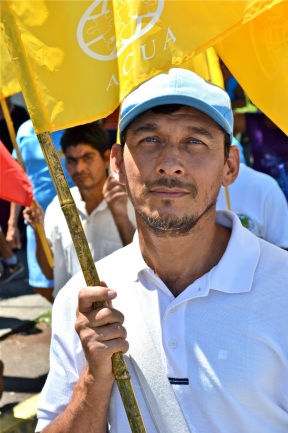
A rural farmer who earns approximately $1 per day. His family will not be able to afford water if it is privatized.
Tired Baby Does Shavasana
August 21, 2013 § Leave a comment
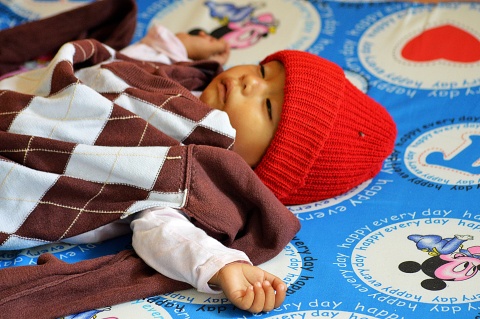
Somebody was snoozing during capacity building…
Who doesn’t like cute baby pictures? This is one from today’s capacity building with farmers from rural communities of El Salvador. The farmers are community leaders who are participating in a Trócaire livelihoods project, made possible thanks to the Big Lottery Fund. The goals of the project are to improve access to water in El Salvador’s most marginalized communities, enable farmers to diversify crops to heighten their families’ food security, promote leadership development, and bring about institutional change at the municipal and State levels through advocacy.
One of the women farmers who participated in today’s training arrived with her daughter. When the baby started getting restless, Super Mom set her down on a Disney mattress, which seemed to have appeared out of nowhere. Judging by the rapid onset of slumber, I’d say it did the trick.
Looking at the baby, I couldn’t help but think what kind of world she’ll be growing up in. How will she fare with the realities of climate change and water contamination that threaten El Salvador, which is one of the top five countries in the world to be most negatively impacted by climate change? Will she be a farmer, like her mom? Will she want to go to school? If so, will she have the means to do so? Will resources find their way to her in a starkly unequal society? Will she use them on shoes, bags, and phones, or will she invest in something that has more value? How will she define value?
The answers to these questions are impossible to know. For now, she sleeps, perfectly oblivious to the fact that she is the cutest baby on the planet.
Ashes, Ashes (a short story)
August 12, 2013 § 2 Comments
“Mikey, I want you to write me a story about Grandma’s ashes.”
I sighed at the demand. As someone who enjoys capturing the random, unrehearsed oddities of everyday life through the written word, I don’t really know how to handle requests.
The request in particular was a shocker, given that it had come from my mother. After all, this was the same woman who stopped talking to me for a full month after I let her read one of my stories that was based on our family. Something to do with how my childhood observations of my parents’ styles of parenting were false representations of reality…
“What about her ashes?” I asked.
“We’re going to scatter them into the lake.”
“That’s interesting,” I said, rubbing at my chin. “She’s only been dead for ten years.”
My mom struck down my sarcasm with a scoff.
“Well you’re home now and it feels like it’s the right time.”
I gently reminded my mother that I had in fact been home ten years earlier. My grandmother died about two months after I graduated from high school. My grandma had been there, watching proudly with her black Chihuahua tucked in her tote bag as I gave the class salutatorian speech. I recall attempting to be philosophical while summarizing the high school experience using nothing but movie titles. That August, my family and I went on vacation to Bermuda, and while there I bought a castle for my castle-loving grandmother made out of Bermuda’s famous pink sand. When I returned home, there was no one to give the castle to, since my grandmother had died in the interim. After days of hearing nothing from my grandma, my mom, older brother, and uncle decided to visit her house in Parsippany. The doors were locked and the keys my mom had been given years ago no longer worked. They called the police, who broke down the door and found my grandma’s body on the floor, naked and already decomposing.
After my grandmother’s wake and cremation, her ashes found an unpoetic home. Not the mountains surrounding Seattle, a city she often reflected upon with wonder. Not Lake Hopatcong, where she would spend many a Sunday with my family on her pontoon, Whiplash Willy. Not in the woods of New Jersey, the state she lived in for the entirety of her 69 years of life. No – instead, my mom stashed away the ashes in the corner of our garage, which smelled perpetually of soot and spilled gasoline. And there they remained for an entire decade.
It wasn’t until I returned home from Latin America for an annual summer visit that my mom finally decided it was time to do the deed and scatter the ashes. It hadn’t been my first summertime visit during those ten years by any means, but my mom operated on the same sort of mom logic that only ever made sense to her.
Though the spreading of my grandmother’s ashes was long overdue, it was obvious that my mother had given a great deal of thought into how it was going to be done. She had been talking about scattering them on Lake Parsippany, where she grew up, at different points throughout the decade. But words had never manifested into action. We should never became we did, and we remained with my grandmother’s ashes at arm’s length. With each day that passed, the ashes grew more distanced in the undusted warehouse of our collective memories.
My mom never got along with my grandmother, who was a difficult person by any measure of the word. Grandma June, as we called her, had named my mom Leah Rose after the ugly sister of the beautiful Rachel in the Bible, a fact she was happy to remind my mother of throughout her childhood. Leah spent her early years thinking she was the least attractive creature in all existence.
June was no caregiver, feeding my mom and her brother a homemade recipe of canned tuna mixed with canned cream of mushroom soup, which she would then pour over white bread. That was if they were lucky enough to receive food at all. To this day, the fishy smell of canned tuna still causes my mom to retch.
When no one else would clean the house, my mother tried to little avail. My grandmother was a hoarder who refused to hang clothes or put objects in their proper places. My mom sought asylum in the homes of her aunts, who felt bad for the poor, dirty, and hungry Leah and would offer her food more out of the kind of pity one might offer a homeless child than love.
As Leah grew up, she blossomed into a gorgeous young woman. Voted best eyes (green), best smile (never wore braces), and most beautiful (bell bottoms, long hair parted at the center), she was the object of desire for many of her male peers. Grandma June resented the fact that her daughter, who was supposed to be the epitome of ugly, ended up turning out to be the opposite. Her disdain was rivaled, if not surpassed, by Leah’s, and the two were destined to never resolve their differences. Soon after she graduated high school, my mother took off from New Jersey to live out her twenties in Hawaii. There she worked in tourism, modeling, and hula dancing, a skill she thrived at with her thin figure and long-brown hair, the tips of which tickled at her thighs.
My grandparents traveled to Hawaii once to see my mom. My grandmother would occasionally reflect on the visit with me, telling me how a crazy artist had started stalking my mom with the hopes of painting her nude. Instead of serving as his muse, my mother had rejected the artist, which only fed his creepy obsession.
My grandma would tell the story with a hint of pride in her voice. Whether she secretly admired my mother’s beauty or was delighted with herself for having given birth to someone of muse-like attractiveness, I’m not sure. What I do know is that my grandmother never shared that story in my mom’s presence. She never said anything nice to my mom, in fact. An “I love you” was never exchanged between the two as far as I knew, perhaps because there was truly no love to be shared. My brothers and I found that odd, as we were expected to say those words on a daily basis to our parents. Our expressions of love never made it to the elder generation, however, since we were never taught to use those words with my mom’s parents. By the time my brothers and I realized what it was we were failing to say, time had made it impossible for us to utter the three simple words without inspiring incredible awkwardness.
Despite what we said or didn’t say, my brothers and I did love our grandmother. We’d see both grandparents every Sunday without fail. They’d drop by the house, normally to take us on day trips to rodeos, flea markets, museums, boat shows, and parks. Every weekend was a different adventure, and every weekend my brothers and I would do something to mess it up. Once we broke the windows of my grandma’s Lincoln Towncar by pressing the buttons too many times. On another occasion, we embarrassed my grandmother when the three of us pestered a cashier at the supermarket to tell us why she was so fat.
Our fighting was relentless, and there was rarely, if ever, a time that my brothers and I were happy to be in each other’s presence. Sometimes my grandparents would drop us off at our home exhausted and angered, my grandmother yelling things like, “I’m never doing that again!” or “They were monsters!” But sure enough, my grandparents would come around the following Sunday to do it all over again.
My brothers and I tamed with age, which made us slightly more pleasant to be around when we weren’t busy being surly or angsty. Before my grandfather died of emphysema, my grandparents would accompany us to most of our sporting events. Even after my grandfather died, Grandma June remained our number one supporter. She was a ferocious fan whose trucker mouth was beyond her or anyone else’s control. Frequent were the times when umpires would threaten to kick the screaming and cussing old lady off of the field. Unwilling to back down from a fight, my grandmother would tear down any opponent with words until she got her way.
Grandma June spent the majority of her nights as a widow tracking my brothers and me. One night she’d be at my older brother Matt’s football game. Then she’d be at my marching band competition (God help her). Then she’d be at my younger brother Mark’s football game. She’d watch me at a jazz concert. Matt wrestling. Mark playing baseball. Me attempting (and failing utterly) to play tennis. By day she was an engineer and by night she was an uber-grandma, keeping tally of our victories and cursing out the opponents who contributed to our losses. One of her favorite pastimes was collecting local newspaper articles that featured us, sharing any news of our successes with her friends, colleagues, and sometimes perfect strangers.
Talking about our achievements, particularly my brothers’ athletic ones, would inspire my grandmother to reflect on her glory days as her school’s softball star. As an old lady, my stout grandma wasn’t the healthiest person in all the land, and she treated exercise as a foreign concept. Her idea of eating healthy was French fries (as potatoes contained an enzyme that no other food did, she’d often remind us) and coleslaw (given the numerous health benefits of cabbage, which may or may not have been negated by excessive globs of Mayonnaise). My grandma suffered from Type II diabetes and was in and out of the hospital a few times, once after having acquired a flesh eating disease. After she survived that ordeal, we were all certain that she’d find a way to outlive breast cancer once she had been diagnosed.
I was often amazed by how my grandma would find ways to use her various illnesses to her benefit. Each time she saw an opportunity to purchase, utilize, and show off a whole new set of hoardable items. After hip surgery, which left my grandmother’s hip feeling as good as new, she refused to take down the handicapped parking permit from her rearview window. For her, handicapped parking was an indefatigable right, even more precious than voting. Regardless of the circumstances, she refused to get out of the car unless she could park it over the image of a stick-figured man in a wheelchair. To further ease her walking, she purchased a series of canes with handles that were formed in the shapes of different animal heads. Her favorite was the whippet since few, if any, people knew what a whippet was. The motor scooter was the climax of my grandmother’s efforts to stop walking altogether, which she would assemble upon exiting her new, and massive, Lincoln Navigator. Once finished, she would sit in the scooter, Chihuahua in one hand, whippet stick in the other. It was her mobile throne.
My grandma’s fascination for things didn’t stop there. She was absolutely obsessed with computers, instruction manuals, and technological gadgets of all sorts. Somehow this fascination skipped a generation. My mom was one of the most computer illiterate people I knew, deliberately avoiding anything technological since she associated it all with my grandmother. My mother would never be caught dead with a clunky camera in her hand or an enormous leather pocket book on her arm, and she walked almost daily to make sure she would never acquire her mother’s heavy figure. If she was destined to be anything, it was not her mother.
Sometimes I didn’t understand why it was that my mother could remain so angry with Grandma June. My grandma went above and beyond the call of duty when it came to grandparenting, which my mom said was the complete opposite of her parenting style. Take gift-giving, for instance. Getting gifts for any of her grandchildren was a well-thought task for my grandma that involved finding what was absolutely perfect for each one of us. She never wasted her time buying me things like football jerseys or autographs of famous athletes. Instead, she’d get me things like art supplies, calligraphy pens, and Native American bead-making sets, always making me promise that I would create something for her with whatever I received.
Grandma June didn’t seek out gifts for her daughter the way she did for her grandchildren. If my grandmother ever splurged on a gift for my mom, she would do so with the singular goal of generating conflict. One example was the costly birthday gift of amethyst earrings – my mom’s birthstone. To any outside observer, the gift was an extremely generous offering from mother to daughter. But anyone who knew my mom, my grandmother included, was aware of how much she hated amethyst in all of its forms. My father had learned long ago that if he was ever going to buy my mother jewelry, amethyst was to be avoided at all costs.
My grandma, on the other hand, claimed to have never gotten the memo.
“I guess I won’t be buying you jewelry ever again,” was my grandmother’s response to the very ungratefulness she helped provoke.
Then there was the time that my parents painted the family room brownish peach. At the time I had no idea why they had chosen the color. It was undoubtedly ugly, so much so that I figured it must have been the only paint they had left at the store. But I wasn’t prepared to vocalize my opinion the way my grandmother did the moment she stepped into the room.
“WHO PICKED THAT DISGUSTING COLOR?”
My mom stood her ground, defending the “earthy peach” that she sacrificed a day painting onto the walls of the room that served as the center of our family activity. It took the intervention of my father and his thunderous wrestler’s voice to quell the ensuing dispute. He answered my grandma the way he might to Macho Man or the Undertaker, booming that the color, ugly or not, was there to stay.
Another silent feud initiated the day my grandma found out that she would have to pay for her wash, haircut, and blow dry at my mom’s new hair salon business. Naturally, she assumed that the procedures would come as a courtesy to the woman who had brought her daughter into the world.
“No,” my mother told her. “You have to pay full price.”
Grandma June remained an occasional customer, albeit an embittered one. That was until the day her stylist left to work at another salon about an hour’s drive away. Instead of switching to someone else, my grandmother followed the old stylist, preferring the out-of-the-way drive to letting my mother think that she had been loyal to the business the entire time.
Of course the stories go deeper. My mother never detailed all of them, but I always imagined theirs being a sort of Cinderella and evil stepmother type relationship. Leah do this! Leah to that! Leah, you can’t go to the ball – you’re too ugly! You’ll never become anything, Leah, because you’re absolutely worthless!
But, like Cinderella, Leah eventually did become something. She was a hard-worker, beautiful, and an adventurer. Plus, she met her Prince Charming – in this case a WWF professional wrestler. She became wealthier than she had ever imagined. She had three children, two dogs, a large mountain home in northern New Jersey, another home in Pennsylvania, and lots of shoes (though none of them glass, to my disappointment). Eventually, she opened her own business, despite the odds and never having gone to college.
In this tale, however, the evil stepmother decided to hang around, condemning Cinderella to weekly Sunday visits just to make sure that the beautiful princess still knew who was in control. My mom never shut the door in my grandmother’s face, even though we had never been invited once to my grandmother’s house, which was just a thirty-five minute drive away. We were fine with that. Our door was always open. In fact, my grandma had her own key and would come and go whenever she pleased.
I don’t think my mom was as sad when my grandmother died as overwhelmed and frustrated by my grandmother’s parting gift – the home that we had never been allowed to enter. The house was no longer a home, per se, but a shelter of junk where the layers of trash were stacked by generation. Newspapers, articles, magazines, correspondence, clippings, technology, and photos from the 60s, 70s, 80s, 90s, and 2000s could be found piled on top of each other in chronological heaps. The collective piles reached the ceiling. There was only a narrow trail that ran from the front door to the kitchen and another that led to the bedroom. Buried in the mass of waste were insulin needles, books, antiques, relics, 1950s Barbie dolls, coin collections, clothes, bags, papers, instruments, and so much more.
My mom was in charge of clearing the house and selling it, which was necessary to pay off what we discovered to be an assortment of unpaid credit card bills. My mom did this by renting a gigantic dumpster and organizing a cleaning committee with family members. The dumpster had to be filled to the brim at least twenty times before the home could be deemed clean. Then she had to worry about clearing out the smells, ripping out the carpets, and scrubbing down the surfaces several times over. Miraculously, my mother was able to sell the home within a few weeks. The money covered the remaining debt and left a few thousand dollars to spare.
Though the process of cleaning the house was smelly and repulsive in almost every way, it was somehow cathartic for my mom. That last task meant that she’d finally be rid of it all – the pain, the turmoil, the stagnating emotions. Some of the discoveries reminded her of her youth. She stumbled upon an old bulletin board that she hadn’t seen since high school. On it were photos of her and her friends, as well as several magazine cut outs of Joe Namath. Apparently she had a thing for burly athletes even then.
My mom would drive me to Parsippany every now and then during my visits back home. We’d pass my grandmother’s house, newly repainted and with fresh landscaping. It’s one of those non-descript homes that one tends to drive by without realizing it. I always have trouble identifying it, but not my mom. I can’t help but wonder what she thinks when we do. Each time she seems shocked by the idea that the structure is still standing.
More of a home to my mother than that house was Lake Parsippany. My mother’s version of the Ganges, the lake was a holy place where she went to get away from it all. It was where she screamed and laughed as a young girl, playing unsupervised with the neighborhood kids. It was where her skin would bronze during the summer months, by happenstance as a child but with intent during her teenage years. In high school, she and her friends would drive around the lake, drinking beers. They’d get stopped by the police, who never gave tickets but would tell them to go home. Over the years, the lake was the oasis that distanced my mother from her reality. Her father’s alcoholism. Her mother’s illnesses. Her future uncertainty.
But she eventually left it, and my grandmother remained. Perhaps that was why it took my mom so long to return to sacrifice her mother’s ashes. Doing so would mean confronting the past in a way that she wasn’t ready to do, while forever connecting her mother to a once sacred place.
The day it came to deposit the ashes, my mother and I found ourselves on the doorstep of Albert Fernini, one of her childhood friends. My mom had bumped into Albert, who still lives on Lake Parsippany, at a car show in Roxbury. When the deceased Grandma June came up in conversation, my mom told Albert that she was thinking about dropping the ashes in the lake. Albert offered his rowboat faster than he could blink.
“Just call me whenever you want, Leah,” he had said. “I’ll have it ready.”
I had heard Albert’s name mentioned on a few occasions over the years. A son of the wrestler Angelo Savoldi (real name: Mario Ferinini), Albert also knew what it like to grow up with a father who beat up other people for a living and who went by two names. It was in the Fernini household that my parents had their first dinner date, since the Ferninis also happened to be friends of my dad. Had it not been for the Ferininis’ approval, my mom might have never married my father, and I might have never ended up on the Albert’s doorstep.
“Poor Albert,” my mother told me as we waited. “I’ve heard he’s not doing well. He’s in a lot of pain.”
Albert’s wife Lynn was the first to welcome us. She was a gentle-seeming woman with thin glasses, a blondish-gray bob, and a golden, New Jersey tan. She and my mother embraced, each one complimenting the other’s appearance with a “You look so good.” The statements, while genuine, translated into something subtler for these women of middle age. “Time has let you off well,” they seemed to be saying.
The same was not true for Albert. Albert was a gray-haired man with a hunching spine and leathery skin who appeared to be at least fifteen years older than my mom. I was shocked when my mother told me later on that he was actually a few years younger. While time had taken its toll on Albert’s appearance, the way something like a World War or several years stranded at sea might, what affected him most was what we couldn’t see. All of Albert’s joints had been infiltrated by unrelenting arthritis. A gas station owner who was used to doing things on his own, he was no longer able to use his hands or fingers for much of anything. Each step he took was an excruciating attack to his ankles, knees, hips, and spine, which was why he now spent most of his days bedridden. Despite the pain, he wanted to see Leah in person.
They talked about old memories and friends. Who was alive and who was dead. The list of the dead seemed to be longer than my mother had imagined. If her life were The Hunger Games, she’d be nearing victory, given all of the childhood friends who had fallen. Victims of cancers, accidents, overdoses, and other diseases.
Cindy, the jovial blonde and one of my mom’s closest childhood friends, arrived to lighten the mood. My mom had wanted Cindy there for strength, and Cindy was more than up for the challenge.
Albert pointed us to the boat. Unable to help us move it, he instructed me on how to ready it so that my mom and Cindy could enter. Apparently I was also expected to row and steer, a task that proved impossible with the two gabbing women who were reminiscing over childhood memories. After a few seconds of spinning in circles, Cindy finally decided to grab one of the oars. With her steering, we were able to make progress. My mom sat at the end of the boat in her shades and silky floral Talbots shirt, looking like a princess who was absolutely unaccustomed to physical exertion of any sort.
Laughing, Cindy and Leah reflected on the times they’d swim out to the raft after a few late-night beers. Most nights would end with food at a local diner or a party at someone’s house. My mom admitted with a coy grin that she and Cindy shared boyfriends.
“Remember Donny Bell, Leah?” Cindy asked.
My mom and Cindy exchanged a playful glance.
“Leah ended up winning him, if I remember correctly,” Cindy said with a laugh. “Not that it matters any more…he’s dead now.”
“Everyone’s dying, aren’t they?” my mom asked.
Leah and Cindy continued laughing. Not at Donny Bell or the fact that they had once fought over the same boy, but at the idea that Donny’s fate would one day be theirs.
Cindy and my mom didn’t go into too much detail about their adolescent memories, thinking that my twenty seven-year-old ears weren’t ready for such knowledge. They went down the roster of those who were alive, those who were ill, and those who had ended life’s bizarre cycle. That transitioned into what they were doing to try to stay in shape.
Once we were in the middle of the lake, the time seemed right to lay down our oars and begin the ritual. Cindy started us off with a prayer, words that encouraged us to think about the loved one we were sending off. A person whose life had brushed against ours, impacting us in a profound way, however we chose to define the nature of the effect.
My mom handed me the heavy paper bag that held my grandmother’s ashes. She had adorned it with three roses that were the color of Belle’s yellow gown on Beauty and the Beast.
“You do it, Michael,” she said.
“Me?” I asked. “Are you sure?”
My mom nodded. “Grandma was the one who cut your umbilical chord. I think it’s only right.”
“She did?” Cindy asked with a gasp. “Oh my God – how appropriate!”
I couldn’t help but visualize my grandmother, who with the slight squeeze of her thumb and forefinger set me free of my mother’s womb and into the world. In comparison, allowing the remains of that very person to sink to the bottom of a large body of water isn’t nearly as rewarding of an act. Instead of being the one who gets to initiate an existence, you are the one who puts it all to an end. You tie the bow on the gift and send it off. You press the stamp on the corner of the envelope and deposit the last letter. You wipe your hands clean after a job well done and sigh, thinking, “Well wasn’t that nice?”
It had been ten years, but I still didn’t feel ready to make it end. My grandmother’s memory persists actively in my mind, and she has the odd habit of appearing in my dreams on a fairly frequent occasion. I’d love to talk to her now, after college, grad school, and over five years of having lived abroad. But talk as I might like to her ashes, they’ll never respond. If anything, they’ll just sit there, collecting dust in the corner of a garage in the least symbolic way possible.
It was time.
I lifted the paper bag onto the side of the boat. The three yellow roses were freshly picked, fully blossomed, and at the peak of their beauty. It didn’t take too much thought to understand what they represented. The imagery reminded me of what one of my grandmother’s closest friends had told my brothers and me at her funeral.
“You boys were the lights of her life.”
We knew it was true. My grandmother had spent so many years in misery, unhappy with herself, unhappy with her marriage, and unhappy with her family. Aside from work, her Chihuahua, and perhaps her motor scooter, the only happiness she ever seemed to find was with us.
I lifted the bag over the boat. The ashes felt like a lead weight, as though they were pressing to go under. I set the bag into the water. It sunk quickly with a few gurgles. I watched as the yellow flowers disappeared into the dark green depths of the lake, accompanying my grandmother’s remains to the bottom.
“Bye, June,” my mother said.
Her face didn’t go pink the way it did whenever she was sad, like it did at our high school graduations or each and every time one of my brothers or I had to leave home to get back to the real world. My mom was glowing beneath the sunlight in a way I had never seen. She had finally given her story to the lake, relieving herself of its weight and allowing the water to do what it had always done. Cure and restore.
“What a voice that June had,” Cindy said. “LEAH! LEAH!”
My mom laughed as Cindy imitated my grandmother’s Roseanne-like shriek. Even after a decade, I remembered it well. A century could pass and it would still be embedded in my memory. The idea, tragic and comical, was also reassuring.
It took me months to sit down and fulfill my mother’s request of writing this story. Despite Grandma June’s death, my burying her, and my day with my mom at Lake Parsippany, I still didn’t feel like I had enough material to tell the tale. My mother never asked me about my progress or how the draft was coming. She probably figured I had forgotten about it or just didn’t care or was too busy with my new job in Nicaragua to think about it.
The last time I visited home over Christmas, my mom brought up Grandma June in conversation – not as a reminder of what I owed her but to add one more element to the story that I had never known.
“She only ever gave me one compliment in my entire life,” my mom told me.
“What was it?” I asked.
“That I was a good mother.”
My mom said the comment as if it meant nothing. To me, it spoke everything. What my grandmother saw and admired in my mother was something that she was incapable of being. She could try to compensate for it by being the kind of super-grandmother who would curse out our nemeses or punch out umpires for the sake of her grandkids. But she could never go back in time and be the mother that my mom and her brother needed. The kind of mother who makes everything from scratch, just so her kids don’t have to dine on tuna, white bread, and preservatives. The kind of mother who refuses to bring you down with words and who tells you she loves you because she knows what it feels like to be unloved. The kind of mother who ties three roses to her mother’s memory despite it all, hoping that, somehow, a spirit will find peace in the presence of the only things that ever seemed to offer solace.
Ring-a-round the rosie,
A pocket full of posies,
Ashes! Ashes!
We all fall down
Face of Change – Access to Education and Technology
August 7, 2013 § Leave a comment
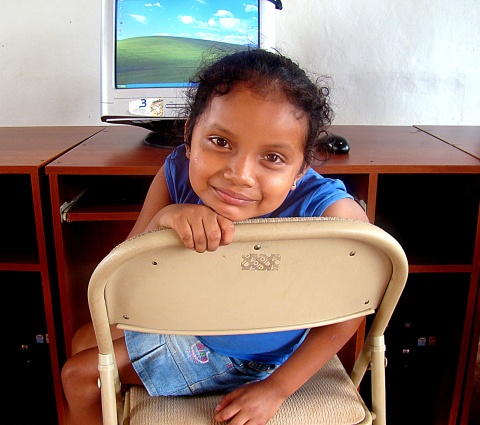
Photo of a young girl in Cuidad Quesada, Costa Rica. She benefits from an educational program offered by the Social Pastoral, one of the partners that Trócaire helps fund in Costa Rica. Understanding how technology and educational facilities impact the lives of the youth is vital for determining the value of community initiatives and interventions. Though the long-term results of this initiative have yet to be measured, what we do know is that these resources and opportunities would most likely not have existed had it not been for the efforts of the Social Pastoral. It also seems like the youth are having a good time learning. (Photo: Michael Solís 2013)
Taking Down Machismo: The “Fight” Against Gender-based Violence
August 4, 2013 § Leave a comment
In 2005 I spent two weeks living with a Costa Rican family. My host mother, Sandra, was a vibrant woman who liked salsa dancing, bright clothes, and chatting over meals and torrential rainstorms.
Sandra’s husband, on the other hand, was a total contrast — expressionless, reserved, and practically mute.
“I married him because he’s not like the rest,” Sandra told me. “He’s never hit me, and he doesn’t sleep around.”
I found it odd that what Sandra’s husband wasn’t could justify their marriage.
What I didn’t realize at the time was that Sandra was protecting herself from a reality that women face around the globe. According to the World Health Organization’s latest report on violence against women, over one-third of all women (over 1.25 billion) have experienced physical and/or sexual violence. Moreover, thirty percent of all women who have been in a relationship have experienced physical and/or sexual violence by their intimate partner.
Sandra’s story remained with me for eight years, until I recently found myself back in Costa Rica evaluating the progress of Trócaire’s Prevention of Gender Based Violence (GBV) Program. Trócaire, an Irish development agency, funds eleven civil society organizations in Nicaragua and Costa Rica committed to preventing GBV and responding to cases of abuse through psycho-social, community, and legal support. The program currently works with 850 women.
One of those women is Teresa. I met Teresa in Upala, Costa Rica at the Center of Migrant Social Rights (CENDEROS). Sitting in the middle of a cluster of adolescents, Teresa played the role of unassuming yet supportive mother. Little did I know the inferno she had been through to get to that seat.
Teresa moved from Nicaragua to Costa Rica with her family when she was eight. She lived with her mother and stepfather, whose relationship eventually dissolved. When she was sixteen, Teresa was forced to marry her step-father, who had already been abusing her for three years. For fifteen more years she experienced a constant mix of physical, verbal, and psychological abuse.
“He was in the war in Nicaragua,” she said, referring to the U.S.-backed Contra War between 1981 and 1989. “He’s still in the war.”
Teresa’s step-father/husband threatened her repeatedly with death. At the same time, he forced her to produce life — six lives to be exact, even though Teresa did not want to bear him any children.
Eventually, Teresa found her escape. She applied for a non-profit housing initiative for low-income women and succeeded in securing a modest home. She packed up her children and moved to San José.
It didn’t take long for Teresa’s husband to force himself back into her life. After tracking Teresa down, he remained violent, his wartime trauma still untreated. On one occasion, he left the house slashing his machete and screaming death threats at the neighbors’ children. A self-made outcast within the barrio, he ultimately left Teresa on his own accord.
Teresa continued taking advantage of every opportunity that non-profit organizations were offering in the area. That was what brought her to CENDEROS, where she participated in psychological counseling and gender training.
For the first time in her life, Teresa vocalized what she had undergone over the previous fifteen years. The act cast her into a tranced, zombie-like state. To this day, she can’t recall any of the details of that session. She only remembers white.
Through CENDEROS, Teresa learned about the law and her rights. She acquired entrepreneurial skills and enrolled herself in primary school, since she hadn’t finished the fifth grade. Today, she is close to graduating from high school. She plans on studying psychology at the university level so she can become a counselor for abused women.
“Despite the violence we’ve experienced, women can move forward,” Teresa says. “We need organizations like CENDEROS. They show us that violence isn’t the way to live. Many women have been able to save their homes. Others haven’t.”
“Migrant women residing in Costa Rica are exposed to sexual harassment, labor exploitation and increased incidence of rape, sexual abuse, and femicide,” says Adilia Solis, Director of CENDEROS. “The conditions of poverty, poor health, rootlessness, and isolation of these populations, the feeling of helplessness that prevails among them, trigger the cycle of violence.”
One of the main reasons for CENDEROS’s success in preventing GBV is that it works directly with boys and men on reconceiving “masculinity” in hyper-machista societies. This involves deconstructing their upbringings, personal traumas, and how their surroundings have shaped their behavior. They come to learn that it is in everyone’s interests to allow women to do basic things like come and go from the home when they choose, share control of economic resources, engage in training and income generating activities, and make decisions.
“When a man says that he’s ready to change, it’s incredible,” Teresa says. “It’s the beginning of a new kind of relationship.”
While Trócaire’s program works with over 770 men in Nicaragua and Costa Rica, challenges persist. There are men involved who still exhibit violent behavior, and there aren’t enough resources to handle the overwhelming demand for individual psychological attention. But changing attitudes and practices prove that it is possible to unlearn machismo.
This prevention work, if replicated at a large enough level, could generate a new way in which men and women interact, inspiring healthier relationships while halting deformational cycles of violence.
The hope of these interventions is not only that women like Sandra and Teresa won’t have to fear “the other” any longer. It’s also so men and women can learn that “the other” is just a social construction — something that facilitates expressions of violence on the basis of nothingness.
This blog post was published previously on Huffington Post on July 31, 2013 and can be accessed here.
The Long Struggle for Justice In Guatemala
July 24, 2013 § 1 Comment
Elena Hermosa, my colleague at Trócaire, traveled to Guatemala on behalf of Trócaire to document the landmark trial of former dictator General José Efraín Ríos Montt and his former chief of Military Intelligence, Mauricio Rodríguez Sánchez for genocide and crimes against humanity.
Guatemala was the scene of one of the most violent armed conflicts in Latin America between 1960 and 1996. It is estimated that 200,000 people were murdered, 45,000 people disappeared and over one million people were displaced.
This documentary tells the story of the Maya Ixil ethnic community’s fight to bring Ríos Montt to justice. 1,771 Ixil Mayan’s were reportedly murdered under Ríos Montt’s regime, amounting to 33% of their total population.
Credits.
Directed and Produced by Elena Hermosa.
Edited by Elena Hermosa and Rodrigo Y. Diaz.

